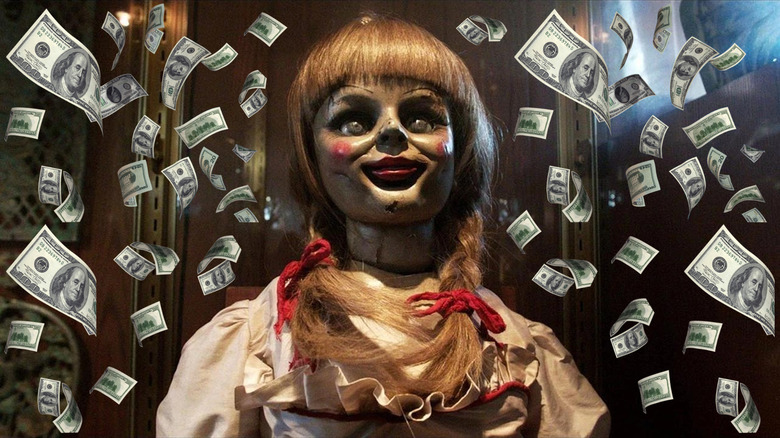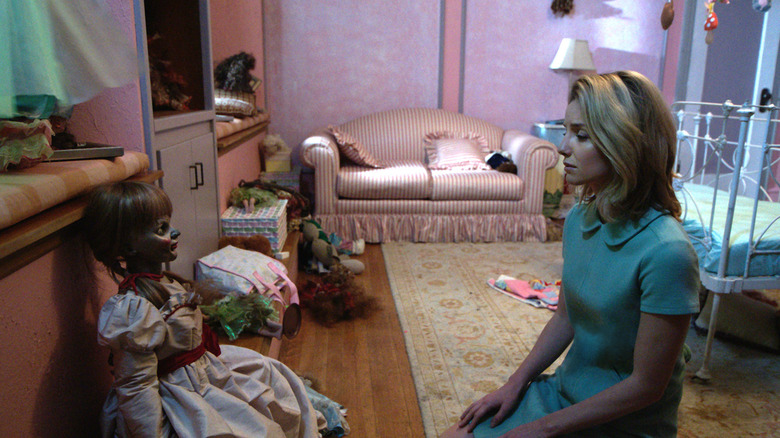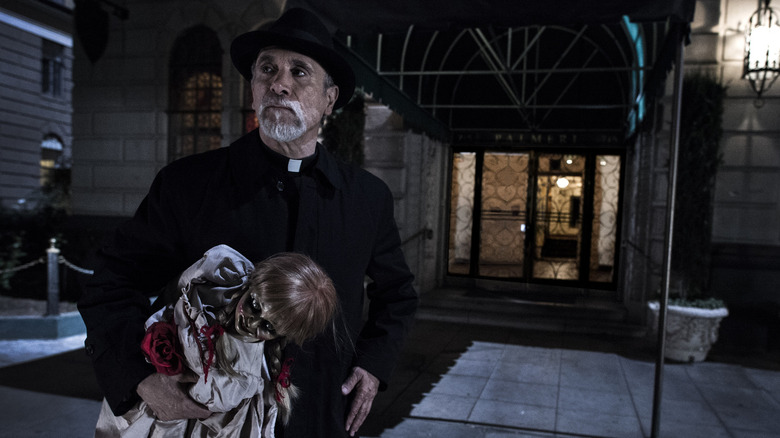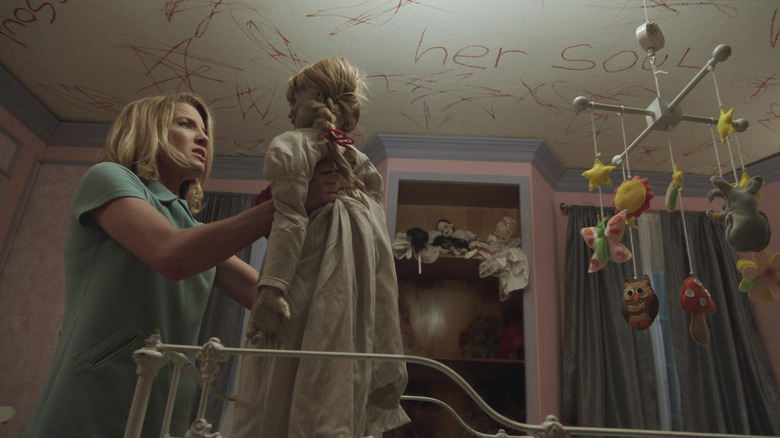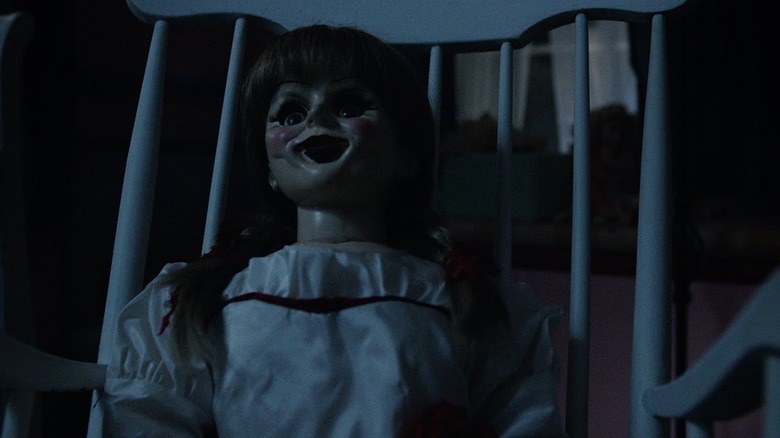A Low-Budget Box Office Juggernaut Spawned The Conjuring Cinematic Universe
(Welcome to Tales from the Box Office, our column that examines box office miracles, disasters, and everything in between, as well as what we can learn from them.)
"Everyone's had dolls, and toys, and things growing up, and you associate those with happy thoughts and good times in your life. So, whenever you come across things that have such a positive association you think you trust, and they deceive you, it becomes all the more scary." Those are the words of Annabelle Wallis, who plays Mia in "Annabelle." Audiences, it turns out, largely agreed with her assessment.
Released in 2014, "Annabelle" was the first spin-off in The Conjuring Universe. It was a smash hit that helped build the one and only $2 billion horror franchise in history. A franchise that is rapidly approaching the $3 billion mark globally at the box office, we might add. It's all pretty impressive for a movie with a mere $6.5 million production budget. More than that, it was a movie that very few people seemed to like at the time. All the same, it was an indisputably important, key part of modern horror's most bankable franchise.
In this week's Tales from the Box Office, we're looking back at "Annabelle" in honor of the recent, record-breaking success of "The Conjuring: Last Rites." We'll go over how the film came to be, how Warner Bros. very rapidly seized on a golden opportunity, what happened when the movie hit theaters, what happened in the aftermath of its release, and what we can learn from it more than a decade later. Let's dig in, shall we?
The movie: Annabelle
The film centers on John Form (Ward Horton), who finds the perfect gift for his pregnant wife, Mia (Annabelle Wallis), in the form of a unique vintage doll. While Mia is delighted with the doll named Annabelle, it all changes when their home is invaded by members of a satanic cult. They conjure an evil, malevolent entity that makes the couple's lives a living hell.
This film traces its roots to director James Wan's "The Conjuring," which became an unexpected smash hit for Warner Bros. in the summer of 2013. It made an astonishing $319 million worldwide against great reviews. Though she wasn't by any means a main character, the Annabelle doll did appear in the film. She made an impression. So much so that the studio set about developing a spin-off centered on the doll. They wasted very little time getting the project in front of the cameras.
Not unlike how the case files of paranormal investigators Ed and Lorraine Warren inspired "The Conjuring," alleged real-life events inspired the tale of "Annabelle." In short, the doll is based on a Raggedy Anne doll that was once gifted to a young woman. After mysterious things started happening, a medium stepped in and claimed it was inhabited by the spirit of a deceased 7-year-old named Annabelle Higgins. The real doll is kept in the Occult Museum founded by the Warrens.
The real doll looks nothing like the one from the movies, but that's where the artistic license comes into play. A then-up-and-coming Gary Dauberman was hired to write the spin-off, with John R. Leonetti ("Mortal Kombat: Annihilation") selected to direct.
Warner Bros. moves quick to make a Conjuring spin-off
"'The Conjuring' is a classy horror film that's different than most in our day and time — it's a different kind of horror movie," Leonetti said to Backstage in an interview in September 2014. "I believe that 'Annabelle' is, too."
It's worth remembering that "The Conjuring" hit theaters in July 2013. By January 2014, "Annabelle" had already assembled a full cast and was due to begin shooting later that month, with a release date set for that fall, just in time for the Halloween season. It was a remarkably quick turnaround. Annabelle Wallis ("The Tudors") and Ward Horton ("One Life to Live") led the cast, with Alfe Woodard ("Desperate Housewives") and Tony Amendola ("Stargate SG-1") also on board.
Filming took just 25 days, with Leonetti and "Conjuring" franchise producer Peter Safran ushering the spin-off through post-production to meet the release date. Leonetti and Safran, in the lead-up to the release, teased actual, strange happenings that took place on set. Safran, speaking to The Hollywood Reporter, relayed this tale:
"The demon was shooting in full makeup, we brought the demon up in the elevator. He walks out and walks around to the green room to where we're holding the talent, and just as he walks under — a giant glass light fixture is being followed by the actor playing the handyman of the building — and all of a sudden the entire glass light fixture falls down on his head, the janitor's head. And in the script the demon kills the janitor in that hallway. It was totally freaky."
The financial journey
By July of 2014, WB had a teaser trailer online for the film, one that leaned very heavily on the creepiness of the titular doll. It proved to be effective, in no small part because "The Conjuring" was still very fresh in the minds of horror lovers the world over. It was just nine months after the home video release, and much closer to the film's debut on cable TV. The only problem? The spin-off was met with scary bad reviews, boasting a lousy 24% approval rating from critics on Rotten Tomatoes. It remains one of the worst-reviewed "Conjuring" movies to date.
Be that as it may, when "Annabelle" hit theaters on the weekend of October 3, 2014, audiences turned up. It made $37.1 million, narrowly missing out on the top spot to "Gone Girl" ($37.5 million). While "Gone Girl" did become a big hit in its own right, it also cost $61 million to make — nearly 10 times what WB's little horror movie did. So missing out on the number one spot hardly mattered. Nor did the lousy reviews. It stuck around for most of October before "Ouija" and "John Wick" kicked it out of the top ten. By that point though, its hit status was firmly cemented.
"Annabelle" finished its run with $84.2 million domestically to go with an outsized $172.7 million overseas for a grand total of $257 million worldwide. Or, to put it another way, nearly 40 times its reported production budget.
Annabelle became a movie star in her own right
In the realm of horror, nothing is more certain than a sequel when success is achieved, particularly on this level. Heck, because horror is often produced on the cheap, even movies that don't make all that much money, relatively speaking, often end up getting follow-ups. It's part of the appeal of the genre. With "Annabelle" being a low-budget movie that made tens of millions in profit, a sequel was put into development.
David F. Sandberg ("Lights Out") was tapped to direct what would become 2017's "Annabelle: Creation," which once again saw Dauberman handling scripting duties. It was an even bigger success, taking in $306.5 million worldwide against an extremely reasonable $15 million budget. Perhaps more importantly, the sequel was considered a marked improvement over its predecessor. Writing for /Film in 2017, Chris Evangelista called "Creation" a "relentlessly frightening, superior horror follow-up."
Dauberman was then elevated to the director's chair for what became the third installment in this creepy doll spin-off series, which materialized in the form of 2019's "Annabelle Comes Home." This installment had the benefit of Vera Farmiga and Patrick Wilson appearing as Ed and Lorraine Warren. Again, it was a huge hit, pulling in $231.2 million globally against a $27 million budget.
That was the lowest-grossing entry in the series, yet it's also the kind of return on investment studios would kill for. All told, the "Annabelle" movies have made just shy of $800 million collectively. But that's truly just the tip of the iceberg.
Annabelle makes The Conjuring Universe possible
Warner Bros. was always going to make "The Conjuring 2," which is exactly what they did. Released in summer 2016, it was also a big hit, taking in $321.3 million worldwide. It cost a lot more than the first movie, but even against a $40 million budget, that was another massive win. That movie also seeded more characters to help build out the future of the franchise, namely Valak, aka the Nun. In 2018, she got a spin-off, too. That was made possible because "Annabelle" worked out so well.
"The Nun," despite lousy reviews, became a global phenomenon, taking in $366 million worldwide. It's the highest-grossing "Conjuring" movie to date, even though that is soon going to change. "The Nun II" ($269.6 million worldwide) was also released in 2023. Then there's "The Curse of La Llorona" ($123.2 million worldwide), which the producers say isn't part of the franchise, even though it clearly takes place in that universe. Semantics aside, it was another hit. WB also released two more mainline "Conjuring" movies, including "The Devil Made Me Do It" ($206.4 million worldwide) in 2021 and, most recently, "Last Rites."
That last one is very important as "Last Rites" opened to an astonishing $194 million globally, setting a new record for the all-time biggest opening for a horror movie ever, overtaking Stephen King's "It." That movie went on to become the biggest horror movie ever, with $700 million worldwide. It speaks volumes about just how much the love for this franchise has grown. As of this writing, it has generated nearly $2.7 billion globally and counting. That number may well reach $3 billion before "Last Rites" is done.
The lessons contained within
Despite its reputation as one of, if not the single worst movie in The Conjuring Universe, "Annabelle" made this wildly successful cinematic universe possible. In terms of return on investment, it's arguably the most successful cinematic universe other than Marvel's. Rather than just relying on sequels with the Warrens, it proved that these haunted case files could inspire many more tales with a sizable global audience.
"Annabelle" wasn't very good. Yet, it made a boatload of cash. Even so, the very low budget worked as something of an insurance policy. It was good business. As budgets continue to get bigger for many franchise films, this feels like something we could use more of.
What Warner Bros., Safran, and Wan wisely did was ensure a course correction with the sequel. "Annabelle: Creation" was very good, which ensured audiences would keep coming back. Similarly, "The Nun II" was viewed as a huge improvement over the first movie. There's a seriously impressive bit of quality control going on here.
Last, but certainly not least, the sheer speed of this venture is hard not to marvel at. The studio managed to capitalize on this spin-off in theaters the following year. It built momentum for The Conjuring Universe as we know it. At the same time, WB never bit off more than it could chew, keeping it to a movie every year or two. Franchise obsession remains pervasive in Hollywood. This remains a gold standard in managing an ever-expanding franchise.
"Annabelle," for all of its perceived faults, was an undeniably key brick in this beloved
